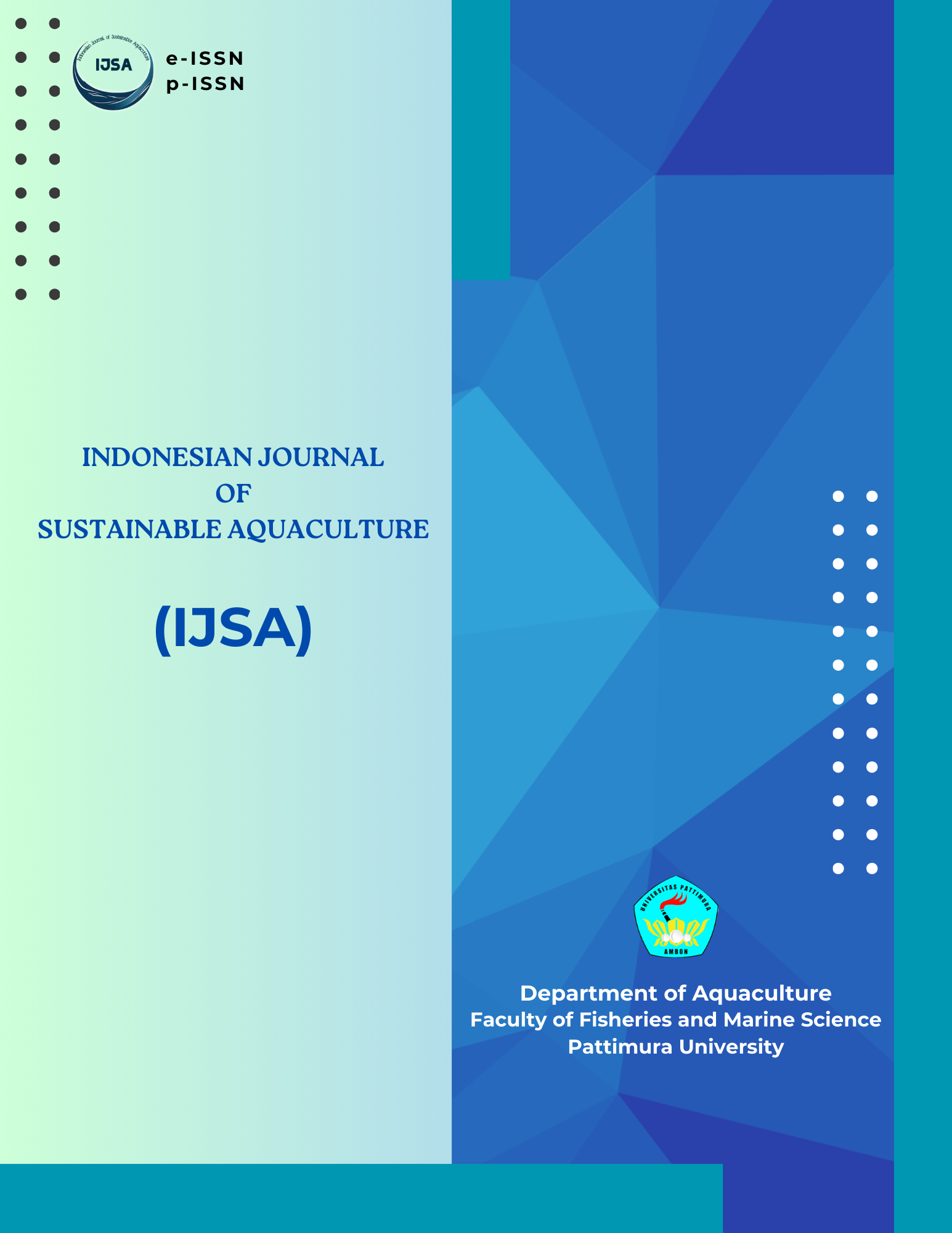Pengaruh komposisi media terhadap pertumbuhan dan kualitas lingkungan kultur Pavlova sp.
Media composition effects on the growth and environmental culture condition of Pavlova sp.
Abstract
To optimise the production of microalgae culture, manipulation of media culture composition is one of the efforts. This study aimed to compare the growth of microalgae Pavlova sp. and the environmental culture conditions between different media compositions. Pavlova sp. was cultured for nine days using three different media compositions: A, B, and C. Cell density was counted daily. The concentration of ammonia, nitrate, and phosphate, as well as total Vibrio and total bacteria, were measured during the culture period on the 3rd, 6th, and 9th day. The result showed that the highest cell density was found in C media (5,08 x 106 cells/ml) followed by B media (4,58 x 106 cells/ml) and A media (4,46 x 106 cells/ml), but statistically, there was not significantly different growth rate between those media (P=0.83 >0.05). Phosphate and nitrate concentrations decreased in all media, but ammonia increased. The total count of bacteria and Vibrio sp. on C media was lower than on A and B media. This finding indicated that the composition of C media was more suitable for the growth and culture environmental condition of Pavlova sp. culture at a semi-massal scale.
Downloads
References
Amin, S. A., Parker, M. S., & Armbrust, E. V. (2012). Interactions between diatoms and bacteria. Microbiology and Molecular Biology Reviews, 76(3), 667-684.
Domingues, R. B., Barbosa, A. B., Sommer, U., & Galvao, H. M. (2011). Ammonium, nitrate and phytoplankton interactions in a freshwater tidal estuarine zone: potential effects of cultural eutrophication. Aquatic sciences, 73, 331-343.
Fuentes, J. L., Garbayo, I., Cuaresma, M., Montero, Z., González-del-Valle, M., & Vílchez, C. (2016). Impact of microalgae-bacteria interactions on the production of algal biomass and associated compounds. Marine drugs, 14(5), 100.
Graham, L. E. & Wilcox, L.W. (2000). Algae. Upper Saddle River, NJ: Prentice Hall Inc.
Guerrini, F., Mazzotti, A., Boni, L., & Pistocchi, R. (1998). Bacterial-algal interactions in polysaccharide production. Aquatic Microbial Ecology, 15(3), 247-253.
Haryanti, M. S., Mahardika, K., Pernama, I. G. N., & Fahrudin. (2010). Kajian Bakteri Pemacu Pertumbuhan Microalgae Sebagai Sumber Pakan Alami Pada Pembenihan Ikan dan Udang. Laporan Akhir. Badan Penelitian dan Pengembangan Kelautan dan Perikanan. Kementerian Kelautan dan Perikanan.
Herlinah. (2010). Karakteristik berbagai spesies Chaetoceros serta analisis pemanfatannya pada pembenihan udang windu (Panaeus monodon). Dewan Riset Nasional Kementerian Negara Riset dan Teknologi. Jakarta.
Jamal E., Loupatty J. W., & Soumokil A. W., (2011) Growth rate and carrageenan content of red and brown morphotypes of Kappaphycus sp. cultured in different light quality at low irradiance. International Indonesia Postgraduate Seminary Proceeding, 88- 95.
Jamal, E., & Luturmas, A. (2016). Some eco-physiological responses of Chlorella vulgaris culture in different environmental conditions. AACL Bioflux, 9(5), 1030-1035.
Jia, F., Kacira, M., & Ogden, K. L. (2015). Multi-wavelength based optical density sensor for autonomous monitoring of microalgae. Sensors, 15(9), 22234-22248.
Lomas, M. W., & Glibert, P. M. (1999). Interactions between NH+ 4 and NO− 3 uptake and assimilation: comparison of diatoms and dinoflagellates at several growth temperatures. Marine Biology, 133, 541-551.
Marwa, M., Raiba, R., & Tuanakotta. (2013). Pengaruh Intensitas Spectrum Cahaya Warna Merah Terhadap Pertumbuhan Chlorella sp. Skala Laboratorium. Jurnal Teknologi Budidaya 4. Balai Budidaya Laut Ambon.
Nybakken, J. W. (1992). Biologi Laut: Suatu Pendekatan Ekologis. PT. Gramedia Pustaka Utama. Jakarta.
Obernosterer, I., & Herndl, G. J. (1995). Phytoplankton extracellular release and bacterial growth: dependence on the inorganic N: P ratio. Marine ecology progress series. Oldendorf, 116(1), 247-257.
Qu, L., Wang, R., Zhao, P., Chen, R., Zhou, W., Tang, L., & Tang, X. (2014). Interaction between Chlorella vulgaris and bacteria: interference and resource competition. Acta Oceanologica Sinica, 33, 135-140.
Rahayu, R. I., & Susilo, H. (2021). Keanekaragaman mikroalga sebagai bioindikator pencemaran di situ cibanten kecamatan ciomas kabupaten serang banten. Jurnal Lingkungan dan Sumberdaya Alam (JURNALIS), 4(2), 104-116.
Reinehr, C. O., & Costa, J. A. V. (2006). Repeated batch cultivation of the microalga Spirulina platensis. World Journal of Microbiology and Biotechnology, 22, 937-943.
Suantika, G., & Hendrawandi, D. (2009). Efektivitas teknik kultur menggunakan sistem kultur statis, semi-kontinyu, dan kontinyu terhadap produktivitas dan kualitas kultur Spirulina sp. Jurnal Matematika dan sains, 14(2), 1-10.
Voltolina, D., del Pilar Sánchez-Saavedra, M., & Torres-Rodríguez, L. M. (2008). Outdoor mass microalgae production in Bahia Kino, Sonora, NW Mexico. Aquacultural engineering, 38(2), 93-96.
Vonshak, A., & Tomaselli, L. (2000). Arthrospira (Spirulina): systematics and ecophysiology. In. The ecology of Cyanobacteria, BA Whitton and M. Potts (Eds), (505-22pp).
Copyright (c) 2025 The Author(s)

This work is licensed under a Creative Commons Attribution-NonCommercial-ShareAlike 4.0 International License.












